

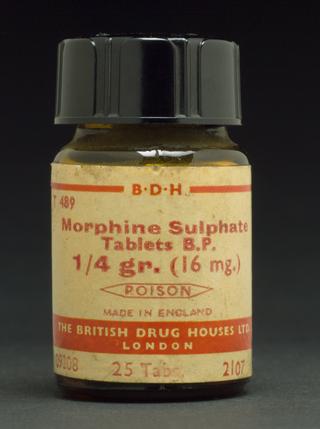
Glass bottle of morphine sulphate
1960-1985

Ammonium Chloride and morphine mixture
1976-1982
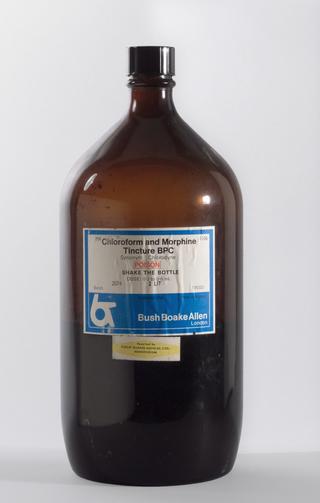
2 litre bottle of Chloroform and Morphine Tincture
1960-1985

Phial of Morphine and Chloroform Tincture
1880-1925
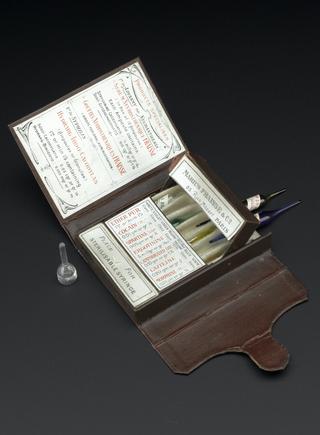
Leatherette injection kit
1901-1910

2 litre bottle of Sedative Bismuth Mixture
1939-1970
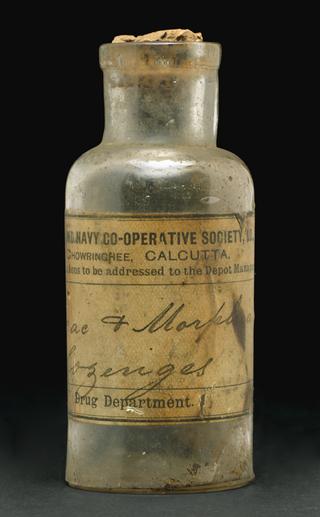
Glass bottle of ipecac and morphine lozenges
1891=1920

Bottle of 'Papine'
1920-1950
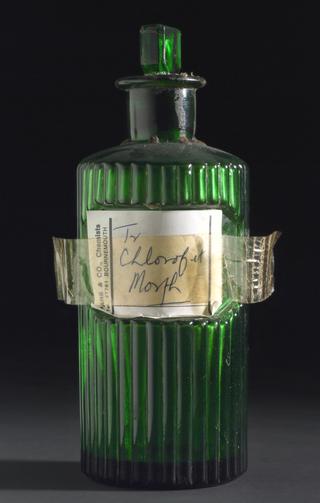
Ribbed green glass poison bottle with glass stopper of Tincture of Morphine and Chloroform
1900-1979
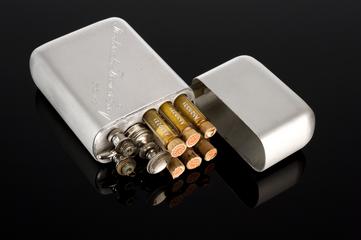
Hypodermic syringe with glass phials of drugs
1885-1910
Three cartons, each containing ten morphine hydrochloride ampoules
Three paper parcels of four cartons containing morphine hydrochloride ampoules
Clear glass
1960-1985
Cardboard box, with sliding drawer, containing six morphine suppositories
‘Monoject’ ampoule syringe of Morphine Hydrochloride
1920-1945
Cardboard box containing brown glass jar
1960-1985
Ampoule containing morphine hydrochloride
1912-1917
Ampoule containing morphine hydrochloride
1912-1917
Bottle, with glass stopper, containing 'Injectio Morphinae Hypodermica, B.P. 1885'
Ampoule of morphine hydrochloride for injection
1900-1960
bottle; controlled drug; morphine
ampoules; controlled drug; morphine
1917
suppository; controlled drug; morphine
Glass phial for morphine sulphate
1885-1920
Ampoule containing morphine hydrochloride
1912-1917
Brown glass bottle labelled to contain 500 ml of ethylmorphine and terpin elixir
Brown glass bottle labelled to contain 500 ml of ethylmorphine and terpin elixir
bottle; controlled drug; morphine
phial; controlled drug; morphine
ampoules; controlled drug; morphine
1913
Bottle of Chlorodyne
1860-1900
Glass phial of morphine sulphate tablets
1890-1930
Shop round for tincture of morphine and ipecac
1850-1900
Wooden chest of drugs in glass phials
1900-1918
Hypodermic syringe case with medicament bottles
1885-1910
Bottle of 'Indigestion Mixture'
1910-1936
Bottle of Elixir Valibrom
1940-1970
Glass drug jar with glass lid for Liquorice and Chlorodyne (morphine and chloroform) pastilles
1840-1910
Bottle of morphine tincture
1880-1920
ampoules; controlled drug; morphine
1917
Bottle of Dakin's Chlorodyne
1920-1940
Glass phial of morphine sulphate tablets
1890-1930
Bottle of Compound Syrup of Cocillana
1901-1950
Bottle of Anodyne Pine Expectorant
1901-1950
bottle; controlled drug; morphine
1851-1900
Leather-covered bottle of Chlorodyne
1906-1920
Bottle of Collis Browne's Chlorodyne
1801-1900
Glass cannister with plastic pop lid and paper label. Canister contains 2 grams of powdered morphine hydrochloride
1960-1985